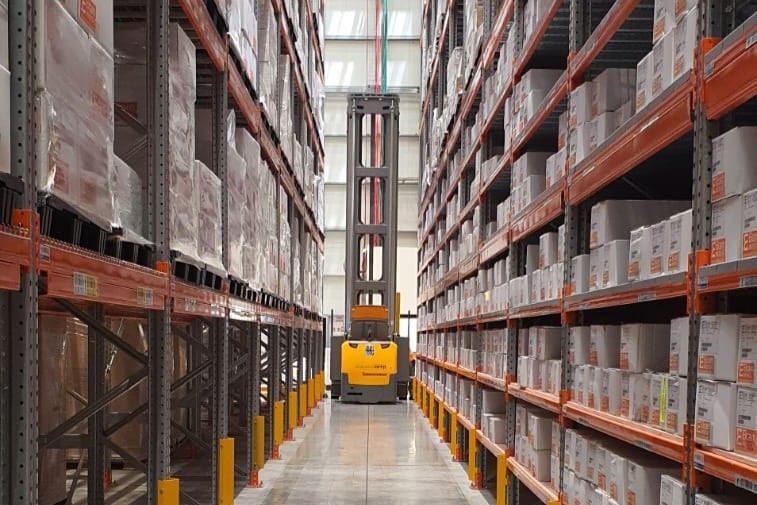
Automated Guided Vehicles (AGVs), also known as self-guided vehicles, represent material handling systems and load carriers designed for seamless navigation within warehouses, distribution centers, or manufacturing facilities, all without the need for onboard operators or drivers.
These are software-driven vehicles tasked with a variety of functions in logistics centers and warehouses. They navigate along predefined routes through the utilization of radio waves, cameras, magnets, or lasers. AGV systems step in to handle tasks traditionally performed by forklifts, conveyor systems, or manual carts, efficiently managing the repetitive movement of large volumes of materials.
AGVs find applications across various domains, including the transportation of raw materials such as metal, plastic, rubber, or paper. There are several categories of AGV systems categorized by their specific functions, including: Automatic Guided Carts (AGCs); Forklift AGVs; Towing AGVs, which operate in train-like formations; Unit Load Handlers tailored for carrying discrete loads like individual objects; and Heavy Burden Carriers designed for the heaviest of loads.
Why are Concrete Floors Crucial to Ensure Optimal AGV System Performance
Automated Guided Vehicles (AVGs) rely heavily on the quality of the floor they operate on to deliver peak performance. There are various key factors explaining why the quality of concrete floors is of utmost importance for optimal AGV system operation:
- AGV Specifics:
AGV systems follow predefined routes using wire, magnetic, or optical guidance. Any obstacles that occur on the floor must be promptly addressed to prevent disruptions in system operation. - Efficiency and Load Considerations:
Floor irregularities become more problematic if AGVs need to travel at higher speeds or transport goods on higher shelves. A smooth floor surface is vital for maintaining efficiency. - Floor Design:
Joints in the floor slab can pose significant challenges for AGV systems. In wire-guided systems, joints can hinder wire installation or route changes. Problems associated with traditional concrete slab shrinkage, such as joint openings, deteriorated joint edges, and curled joints can cause operational issues. - Floor Surface Quality:
Floor surface friction and micro-roughness are crucial for ensuring traction between the floor and AVG wheels, following vendor specifications.
Abrasion resistance is vital, as robotic traffic is repetitive and wear resistance is crucial for the floor's durability.
By addressing these factors and maintaining high-quality concrete floors, businesses can optimize the performance and longevity of their AGV systems, ultimately enhancing operational efficiency in various warehouse environments.
Why PrimX Concrete Technology is a Game Changer for AGV Systems
- Lifetime Flatness: The PrimX slab boasts lifelong flatness, maintaining its level surface from casting onwards. This attribute is particularly valuable for Automated Guided Vehicle (AGV) operations, guaranteeing an impeccably flat and precise surface that optimizes performance. There is no need for costly grinding works due to lost surface tolerance, which is often needed for regular concrete slabs.
- Seamless, Jointless Design: The absence of joints or irregularities on the surface ensures unhindered functionality for precision-driven technologies. Moreover, a jointless design significantly reduces maintenance requirements, as joints are typically the weakest points in a slab's structure.
- Reduced CO2 Emissions and Environmental Sustainability: PrimX slabs provide greater load-bearing capacity with identical thickness to a traditional floor and greater load-bearing capacity with a thinner PrīmX floor compared to a thicker traditional one, resulting in substantial reductions in CO2 emissions. This achievement stems from a deliberate reduction in material consumption, facilitated by an optimized structural design, strategic selection of smart materials with minimized environmental levies, and the streamlining of construction processes.
- Dimensional Stability and Stiffness
PrimX (SFRSSC) Steel Fiber Reinforced Self-Stressing Concrete ensures an exceptionally sturdy and durable slab, providing a robust and long-lasting platform for heavy and precision-driven automated systems. - Faster Construction:Prīm X SFRSSC offers the advantage of being ready for use in just 14 days after pouring. Unlike traditional concrete floors, which necessitate a 30 day curing period. PrīmX lets you get your facility up and running faster. The substantial decrease for steel bar reinforcement in the floors and more efficient and productive construction techniques lead to accelerated construction timelines and enhanced overall efficiency in the building process.
- Cost-Efficiency: PrimX technology offers cost savings through optimized slab designs, simplified construction processes, reduced construction durations, and shorter overall schedules.